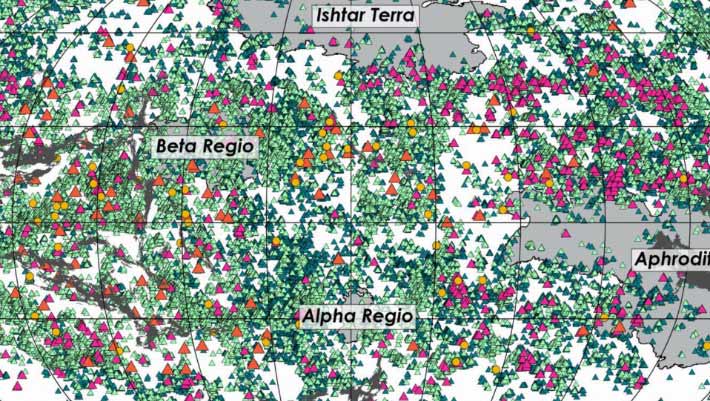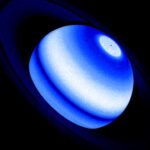There are many thousands of volcanoes on the surface of Venus. These volcanoes provide clues into the interior properties of the planet, properties that are otherwise largely inaccessible to scientists at present. In new research, planetrary researchers used the Synthetic Aperture Radar (SAR) imagery from NASA’s Magellan mission to catalog volcanoes across Venus at a global scale. The resulting database contains approximately 85,000 volcanoes, 99% of which are less than 5 km (3 miles) in diameter.
This map shows shield volcanoes on Venus. Image credit: Rebecca Hahn, Washington University in St. Louis.
“Our paper provides the most comprehensive map of all volcanic edifices on Venus ever compiled,” said Dr. Paul Byrne, a planetary scientist at Washington University in St. Louis.
“It provides researchers with an enormously valuable database for understanding volcanism on that planet — a key planetary process, but for Venus is something about which we know very little, even though it’s a world about the same size as our own.”
In their research, Dr. Byrne and his colleague, Washington University in St. Louis graduate student Rebecca Hahn, used radar imagery from NASA’s Magellan mission to catalog volcanoes across Venus at a global scale.
Their database contains 85,000 volcanoes, about 99% of which are less than 5 km in diameter.
“Since NASA’s Magellan mission in the 1990s, we’ve had numerous major questions about Venus’ geology, including its volcanic characteristics,” Dr. Byrne said.
“But with the recent discovery of active volcanism on Venus, understanding just where volcanoes are concentrated on the planet, how many there are, how big they are, etc., becomes all the more important — especially since we’ll have new data for Venus in the coming years.”
The team’s study includes detailed analyses of where volcanoes are, where and how they’re clustered, and how their spatial distributions compare with geophysical properties of the planet such as crustal thickness.
Taken together, the work provides the most comprehensive understanding of Venus’ volcanic properties — and perhaps of any world’s volcanism so far.
That’s because, although we know a great deal about the volcanoes on Earth that are on land, there are still likely a great many yet to be discovered under the oceans.
Lacking oceans of its own, Venus’ entire surface can be viewed with Magellan radar imagery.
Although there are volcanoes across almost the entire surface of Venus, the scientists found relatively fewer volcanoes in the 20-100 km (12-62 miles) diameter range, which may be a function of magma availability and eruption rate.
They also wanted to take a closer look at smaller volcanoes on Venus, those less than 5 km across that have been overlooked by previous volcano hunters.
“They’re the most common volcanic feature on the planet: they represent about 99% of our dataset,” Hahn said.
“We looked at their distribution using different spatial statistics to figure out whether the volcanoes are clustered around other structures on Venus, or if they’re grouped in certain areas.”
The team’s paper was published in the Journal of Geophysical Research: Planets.
_____
Rebecca M. Hahn & Paul K. Byrne. A Morphological and Spatial Analysis of Volcanoes on Venus. Journal of Geophysical Research: Planets, published online March 24, 2023; doi: 10.1029/2023JE007753




